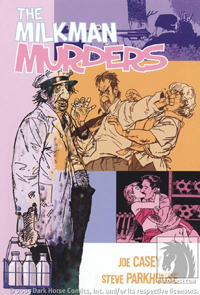Comics /
Comic Reviews /
More Comics
The Milkman Murders
By Philip Schweier
July 13, 2007 - 17:36
Dark Horse editor Scott Allie likens
The Milkman Murders to a horror story in his introduction. He says horror is more an emotion than a genre, and that Casey and Parkhouse capitalize on this idea as their story tragically, gruesomely unfolds. Barbara Vale is a typical suburban housewife whose middle class dream has become a nightmare. She tries vainly to prod her family “into the light” as it is represented on television, until a personal incident clarifies the futility of her efforts. Unable to go up, she instead spirals downward into the kind of insanity we read about all to frequently in our daily newspapers. Horror indeed.
Casey’s characters at first seem clichés, but only if they were given some 21st century version of “they all lived happily ever after” ending. Instead, Casey chooses them to follow a path established by their own nature, allowing each to remain true until the very end. Closer examination suggests they are nuclear family archetypes after the bomb has dropped and survivors have begun to mutate. Like
Married With Children gone from bad to worse, they squabble, toil away at meaningless generic jobs, existing rather than living in suburbia.
Parkhouse’s figures have distinct cartoon quality, but this perhaps reinforces the idea that they are caricatures drawn from everyday life. Part of the charm of his artwork is the background subtleties, such as a detergent that promises “a whiter nation,” suggesting that Barbara Vale’s middle class dream isn’t all it’s cracked up to be. Instead of wondering why Barbara Vale takes her ultimate path, it left me wondering why it didn’t happen sooner.
Last Updated: August 31, 2023 - 08:12
